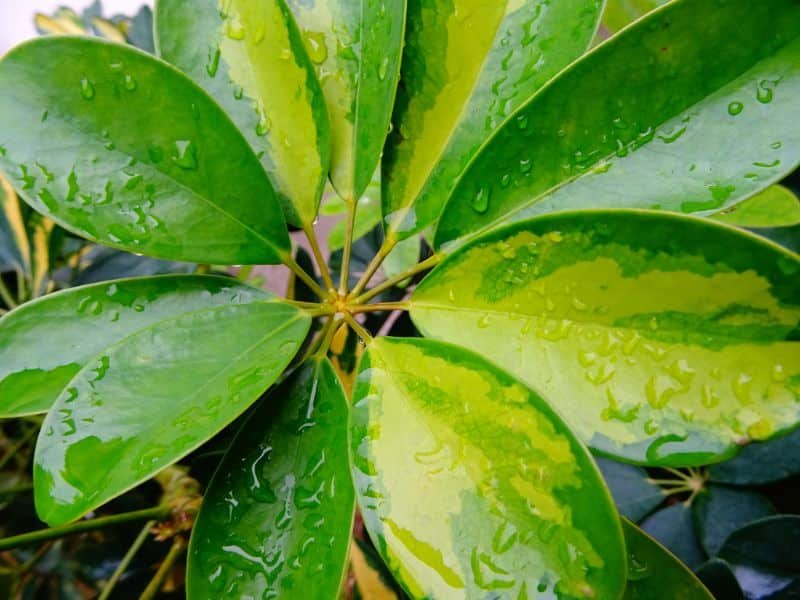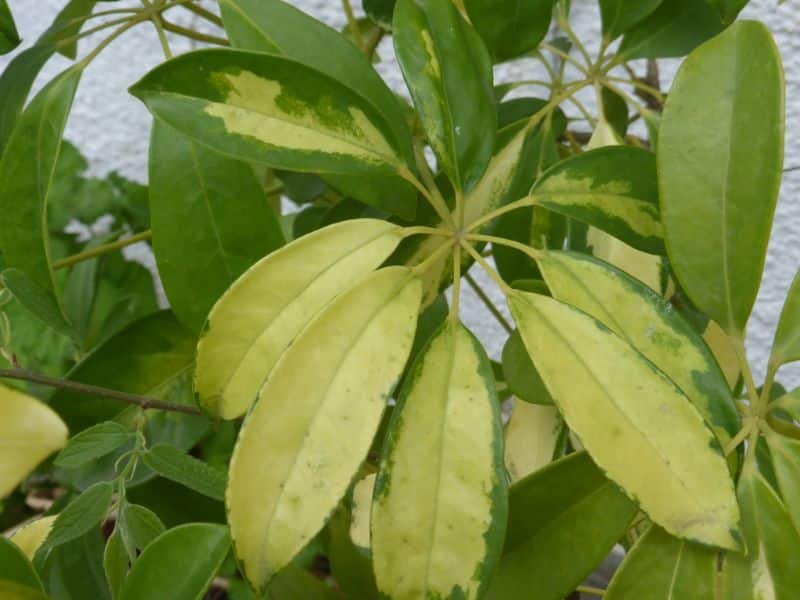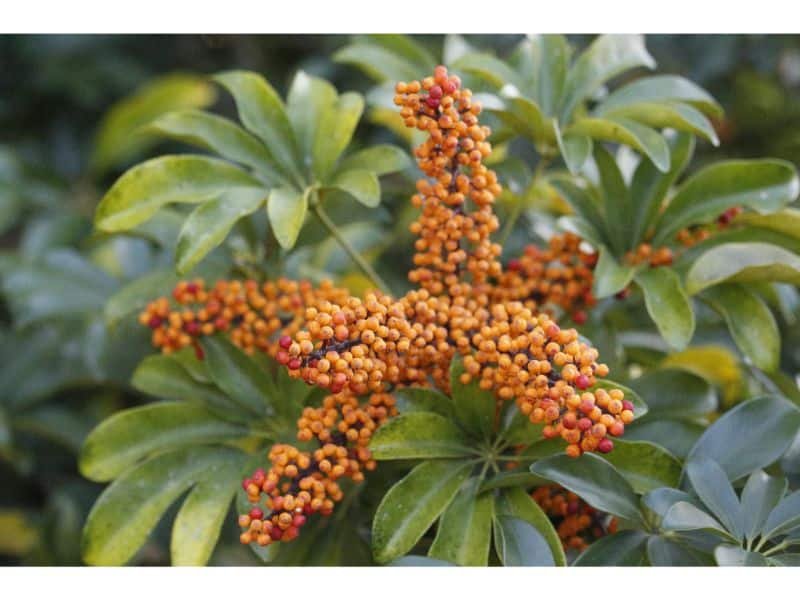Are you looking for a stunning and low-maintenance plant to enhance your indoor space? Look no further than the Schefflera Moondrop! With its beautiful foliage and easy care requirements, this tropical plant is a perfect choice for both experienced gardeners and beginners alike.

Table of Contents
Overview of Schefflera Moondrop
The Schefflera Moondrop, scientifically known as Schefflera arboricola, is a popular member of the Araliaceae family. It is native to Taiwan and Hainan Island in southern China. This plant is characterized by its glossy, dark green leaves that resemble miniature umbrellas, hence its common name, “umbrella tree.” The Moondrop variety is a unique cultivar that features leaves with beautiful, contrasting variegation, adding a touch of elegance to any indoor space.
Plant Characteristics
The Schefflera Moondrop plant, also known as Schefflera arboricola ‘Moondrop,’ is a captivating addition to any indoor garden. Its unique appearance, from foliage to flowers and height, adds a touch of elegance and beauty to your living space.

Foliage:
The foliage of the Schefflera Moondrop is the highlight of this plant. Its glossy, dark green leaves create a lush and vibrant display. What sets this variety apart is its stunning variegation. The leaves feature contrasting shades of green, cream, and yellow, which add a striking and eye-catching element to the plant’s overall appearance. The variegation patterns can vary from plant to plant, making each Schefflera Moondrop unique and visually appealing.
Flower:
While the Schefflera Moondrop is primarily grown for its foliage, it does produce small flowers under ideal conditions. The flowers are relatively inconspicuous and are typically white or cream in color. These delicate blooms add a subtle beauty to the plant but are not the main attraction. It’s the foliage that steals the show with its vibrant colors and lushness.
Height:
In terms of height, the Schefflera Moondrop is a relatively compact plant, making it suitable for various spaces in your home. It typically reaches a height of about 3 feet (0.9 meters) when grown indoors. This compact size allows you to place it on tabletops, shelves, or as a floor plant without overwhelming the space. Its manageable height makes it an excellent choice for those looking to add greenery to smaller rooms or apartments.
The Schefflera Moondrop’s overall appearance with its glossy, variegated foliage, subtle flowers, and compact height makes it an ideal choice for enhancing the visual appeal of your indoor space.
Growing Requirements

– Light and Temperature
Schefflera Moondrop plants thrive in bright, indirect light. Placing them near a north or east-facing window is ideal, as it provides the right balance of sunlight without exposing the plant to harsh direct rays. As for temperature, this plant prefers a warm environment, with temperatures ranging from 65°F to 75°F (18°C to 24°C). Avoid exposing it to cold drafts or extreme temperature fluctuations.
– Watering and Humidity
When it comes to watering, it’s important to strike a balance. Overwatering can lead to root rot, while underwatering can cause the leaves to wilt and drop. As a general rule, allow the top inch of soil to dry out before watering again. The Schefflera Moondrop appreciates moderate humidity, so misting the leaves or using a humidifier can help maintain optimal conditions.
– Schefflera Moondrop Soil Preference
The Schefflera Moondrop, with its vibrant foliage and compact size, thrives when provided with the right soil conditions. Choosing the appropriate soil type and ensuring proper drainage is essential for the health and growth of this remarkable plant.
Well-Draining Soil:
The Schefflera Moondrop prefers well-draining soil that allows excess water to flow through easily. The ideal soil composition consists of a mix of organic matter, such as peat moss or compost, and a well-balanced potting mix. This combination helps to retain moisture while also providing adequate drainage to prevent waterlogging, which can lead to root rot and other detrimental conditions.
Moisture Retention:
While it’s crucial for the soil to drain well, the Schefflera Moondrop also appreciates a slightly moist growing medium. The soil should be kept evenly moist, but not overly saturated. Water the plant thoroughly when the top inch of soil feels dry to the touch. Be cautious not to overwater, as excessive moisture can lead to root issues. Regularly monitor the soil’s moisture level and adjust your watering schedule accordingly.
pH Level:
Maintaining the proper pH level of the soil is vital for the Schefflera Moondrop’s health. It thrives in slightly acidic to neutral soil, with a pH range between 5.5 and 7.0. You can test the pH level using a soil testing kit, available at most garden centers or online. If the pH level is outside the desired range, you can make adjustments by adding suitable amendments, such as sphagnum peat moss or garden lime, to achieve the optimal pH level.
Container Planting:
When planting the Schefflera Moondrop in a container, ensure that it has drainage holes at the bottom to allow excess water to escape. Use a pot with a size appropriate for the plant’s current size, providing enough room for root growth. Transplant the plant to a larger pot as it outgrows its current container, refreshing the soil mixture during the process.
By providing well-draining soil, maintaining proper moisture levels, and ensuring an appropriate pH level, you can create an optimal growing environment for your Schefflera Moondrop plant.
Propagation Methods

Propagating the Schefflera Moondrop allows you to expand your plant collection or share its beauty with others. There are a few different methods you can use to propagate this plant, including stem cuttings and air layering. Let’s explore each technique in detail to ensure successful reproduction.
Propagation through Stem Cuttings:
- Select a Healthy Stem: Choose a healthy stem from the Schefflera Moondrop plant that is free from any signs of damage or disease. Ideally, the stem should be about 4-6 inches long.
- Prepare the Cutting: Using clean and sharp pruning shears, make a clean cut just below a leaf node (where a leaf is attached to the stem). This node is essential for the development of new roots.
- Remove Lower Leaves: Strip off the leaves from the lower one-third to one-half of the stem. This helps direct the plant’s energy toward root development rather than maintaining the foliage.
- Optional: Apply Rooting Hormone: While not necessary, you can dip the cut end of the stem in a rooting hormone powder or gel to encourage faster root growth. This step is particularly useful if you want to increase the chances of successful propagation.
- Plant the Cutting: Fill a small pot with a well-draining potting mix. Make a hole in the soil using your finger or a pencil and insert the cut end of the stem into the hole. Gently press the soil around the cutting to secure it in place.
- Provide Ideal Conditions: Place the potted cutting in a warm and humid environment, preferably under bright, indirect light. You can cover the pot with a plastic bag or place it in a propagation tray to create a mini-greenhouse effect that retains moisture.
- Maintain Moisture: Keep the soil consistently moist but not overly saturated. Water the cutting whenever the top inch of the soil feels dry to the touch.
- Root Development: Within a few weeks, roots will start to develop from the cut end of the stem. You can gently tug on the stem to check for resistance, indicating the presence of roots.
- Transplanting: Once the new plant has established a healthy root system, typically after several weeks to a couple of months, you can transplant it into a slightly larger pot filled with well-draining soil. Continue caring for the plant as you would for a mature Schefflera Moondrop.
Air Layering:
- Select a Suitable Stem: Choose a healthy stem with multiple leaf nodes that is flexible enough to manipulate. Avoid using overly woody or rigid stems.
- Make an Incision: Below a leaf node, make a small incision or wound on the stem. You can use a sharp knife or a clean blade to create a shallow cut or remove a thin strip of bark.
- Apply Moist Sphagnum Moss: Take damp sphagnum moss and wrap it around the wounded area on the stem. Ensure the moss covers the entire incision and extends a few inches above and below it.
- Enclose with Plastic Wrap: Cover the moss layer with a sheet of clear plastic wrap or a plastic bag. Secure the plastic wrap above and below the moss layer using twist ties or string. This creates a humid environment ideal for root development.
- Monitor and Wait: Over the next few weeks to a couple of months, roots will start to form within the moss layer. Check periodically by gently removing the plastic wrap and moss to inspect the progress.
- Cut and Pot (continued): Once the roots are well-developed, cut the stem below the moss layer, ensuring you have a section with new roots. Remove the plastic wrap and moss carefully.
- Plant in a Pot: Prepare a pot with well-draining soil. Make a hole in the soil and gently place the rooted section of the stem into the hole. Press the soil around it to secure the plant in place.
- Provide Proper Care: Place the potted air-layered Schefflera Moondrop in a location with bright, indirect light. Keep the soil consistently moist but not waterlogged. Maintain a warm and humid environment to support the plant’s growth.
- Continued Care: As the new plant establishes itself, continue to care for it as you would for a mature Schefflera Moondrop. Provide regular watering, adequate light, and occasional fertilization to encourage healthy growth.
Propagation through stem cuttings and air layering are effective methods to reproduce the Schefflera Moondrop plant and expand your collection. By following these step-by-step instructions and providing proper care, you can successfully propagate this beautiful plant.
Common Pests and Diseases
While the Schefflera Moondrop is generally a resilient plant, it can still be susceptible to certain pests and diseases. Some common pests that may affect this plant include spider mites, mealybugs, and aphids. Regularly inspect the leaves for any signs of infestation and treat them accordingly using natural or chemical pest control methods.
Regarding diseases, overwatering can lead to root rot and fungal infections. To prevent these issues, ensure proper drainage and avoid overwatering the plant. If you notice any signs of disease, such as yellowing or wilting leaves, take action promptly by adjusting the watering regimen and providing proper air circulation.
Pruning and Maintenance
Regular pruning is essential to maintain the shape and size of the Schefflera Moondrop. Prune any yellow or dead leaves to encourage new growth. You can also trim back leggy stems to promote a bushier appearance. Pruning should be done during the active growing season using clean and sterilized pruning shears.
Additionally, wiping the leaves with a damp cloth periodically helps remove dust and keeps them looking vibrant. This also allows the plant to absorb more light, aiding in photosynthesis. Remember to wear gloves when handling the plant, as its sap may cause skin irritation.
Benefits of Schefflera Moondrop
Apart from its visual appeal, the Schefflera Moondrop offers several benefits. It is known to improve indoor air quality by removing toxins and releasing oxygen. The presence of greenery has a calming effect, reducing stress and enhancing overall well-being. Moreover, caring for indoor plants like the Schefflera Moondrop can be a rewarding and fulfilling hobby.
Incorporating this plant into your home or office space not only adds beauty but also contributes to a healthier environment and a more pleasant ambiance.
Schefflera Moondrop Plant Toxicity
The Schefflera Moondrop, with its stunning variegated foliage and easy care requirements, is a popular choice for indoor gardens. However, it’s important to be aware of the potential toxicity of this plant to ensure the safety of both humans and pets.
Toxicity to Humans
The Schefflera Moondrop contains calcium oxalate crystals, which are toxic if ingested. These crystals can cause irritation and discomfort in the mouth, throat, and digestive system. Symptoms of ingestion may include burning or swelling of the lips, tongue, and throat, as well as difficulty swallowing.
If you or someone you know accidentally consumes any part of the Schefflera Moondrop plant and experiences these symptoms, it’s crucial to seek immediate medical attention. Rinse the mouth with water and do not induce vomiting unless instructed by a healthcare professional.
Toxicity to Pets
Pets, particularly dogs and cats, may be curious about plants and sometimes chew on them. It’s important to note that Schefflera Moondrop is considered toxic to pets if ingested.
When pets consume parts of the Schefflera Moondrop, they may exhibit symptoms such as drooling, pawing at the mouth, vomiting, diarrhea, or difficulty breathing. In severe cases, it can lead to more serious complications.
If you suspect that your pet has ingested the Schefflera Moondrop or shows any signs of toxicity, contact your veterinarian immediately. They will provide guidance on the best course of action, which may include inducing vomiting or other appropriate treatments.
Preventive Measures for Safety
To ensure the safety of both humans and pets, it’s essential to take preventive measures when having the Schefflera Moondrop plant in your home:
- Keep the plant out of reach: Place the plant in a location where it’s inaccessible to children and pets, especially curious cats or dogs who may be tempted to chew on the leaves.
- Educate family members and visitors: Make sure everyone in your household is aware of the potential toxicity of the Schefflera Moondrop. Inform guests about the plant’s toxicity to prevent accidental ingestion.
- Consider alternative plants: If you have pets or young children in your home, you may want to consider selecting non-toxic houseplants as a safer alternative.
By being proactive and taking these precautions, you can enjoy the beauty of the Schefflera Moondrop while keeping everyone in your household safe.
Conclusion
In conclusion, the Schefflera Moondrop is a remarkable plant that combines beauty, ease of care, and air-purifying qualities. With its variegated foliage, compact size, and tolerance to a variety of growing conditions, it is an excellent choice for indoor gardening enthusiasts. By following the proper care guidelines, including providing adequate light, appropriate watering, and regular maintenance, you can enjoy the vibrant presence of the Schefflera Moondrop in your indoor space.
Frequently Asked Questions (FAQs)
Can I place my Schefflera Moondrop in direct sunlight?
It’s best to avoid direct sunlight as it can scorch the leaves. Opt for bright, indirect light instead.
How often should I water my Schefflera Moondrop?
Allow the top inch of soil to dry out before watering. It’s better to underwater than overwater this plant to prevent root rot.
Can I grow Schefflera Moondrop outdoors?
Schefflera Moondrop is primarily suited for indoor cultivation. However, in warm climates, it can be grown outdoors in shaded or partially shaded areas.
Is the Schefflera Moondrop toxic to pets?
Yes, Schefflera plants, including the Moondrop variety, can be toxic to pets if ingested. It’s best to keep them out of reach of curious pets.
How fast does the Schefflera Moondrop grow?
The growth rate of Schefflera Moondrop can vary, but under optimal conditions, it can grow several inches per year.
Can I place my Schefflera Moondrop near an air conditioner or heater?
It’s advisable to keep the plant away from direct drafts caused by air conditioners or heaters. Extreme temperature fluctuations can be detrimental to its health.

Gardening is my passion and growing plants indoors has always been a stress relief for me. Grow a banana tree in my apartment once (although failed to produce bananas).






